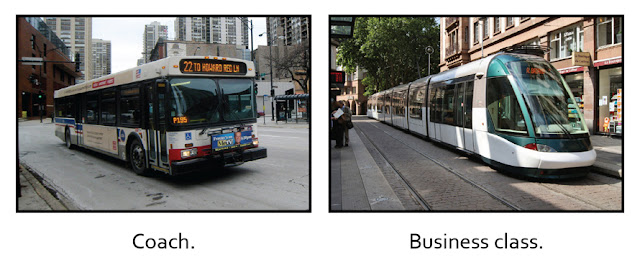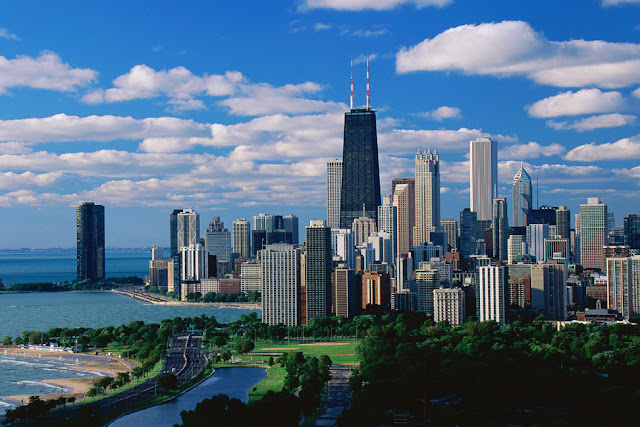The Clark Street corridor runs through a series of north-side neighborhoods between the Red Line elevated train and the lakefront—the area far enough east that transit riders take the bus because it’s too far to walk to the L.
This is the most densely populated area of Chicago, and the four zip codes with the highest transit ridership in the city. Over 70,000 people board buses on an average weekday in the Clark Street corridor—that’s more than on the average elevated train line.
Car commuters are a minority here, and almost all who drive to work are headed for the suburbs or for the Loop via Lake Shore Drive. Clark is too narrow to be a good commuting route for most drivers—it was designed for streetcars and pedestrians, and has become choked with through traffic. There’s too much congestion and not enough parking for Clark Street to be an attractive place to shop by car, so local business depends almost entirely on foot traffic.
Half of the buses in the corridor run down Clark Street itself, crawling through heavy rush-hour traffic at little more than walking pace. The other half avoid that traffic by running along the outside of the neighborhood near the lakefront. There’s less congestion there, but no businesses, so commuters forego the convenience of shopping on the way home and local business loses the benefit of all that foot traffic.
It’s a tough compromise. It would be better for commuters and for local business owners if all the buses went down Clark, through the heart of the neighborhood business district, but there’s just too much car traffic for that.
It seems to me we have four choices.
First, we could do nothing: stick with the bus system we have. As the city grows, increasing congestion will force more drivers onto buses, but those buses will be stuck in traffic too, running slower and slower every year. Our inefficient transit system and worsening traffic congestion are already costing us $7.3 billion annually in wasted time, and have become a powerful barrier to economic growth.
Second, we could make it easier to drive through the neighborhood by removing the bike lanes, parking, and trees and narrowing the sidewalks. We could add another lane to Lake Shore Drive going each direction. That would bring a lot more cars into downtown, and we’d have to figure out what to do with them (maybe build some high-rise parking structures with automated car elevators?). And expanding LSD would be really, really expensive: about $100 million per mile. Unfortunately, adding more capacity to urban highways just encourages more people to drive, so the additional capacity fills up quickly until congestion was as bad as before.
Third, we could build a new heavy-rail elevated train line along the periphery of the neighborhood or a subway beneath Clark Street. Unlike the road infrastructure, the train service would become more frequent and cheaper per trip as more people used it, which would encourage economic growth while alleviating congestion. But at $300 million per mile, elevated trains and subways have become so expensive that almost no one’s building them anymore.
Fourth, and finally, we could consolidate transit service from the periphery to Clark Street, bringing commuters through the heart of the neighborhood business district where they can combine commuting and shopping. We could move car traffic from Clark out to the periphery, where there’s less congestion. That would allow transit to move freely in a dedicated lane rather than being stuck in traffic, which would make the commute much faster and attract many to take transit instead of driving. That would essentially make Clark Street a bus rapid transit (BRT) route.
But we already have over 70,000 daily bus boardings—even if faster service and convenient shopping didn’t attract any new riders, which they surely would. With that kind of transit ridership (more than most elevated train lines), it would be cheaper to invest in upgrading to light rail—a modern electric streetcar running in a dedicated lane down Clark Street. At $30 million per mile, it’s a big investment, but a lot less than building more roads and only about 10% of the cost of an elevated train or subway. And because each driver of the long, articulated modern streetcar can transport two or three times as many passengers as on a bus (288 instead of 84 or 125), and since the drivers account for 75% of the operating cost of a transit system, streetcars would be much cheaper to operate than buses, saving taxpayers money in the long run. The fact that they don’t pollute, are safer to be around because they move predictably on rails, and increase property values (buses don’t) are all added bonuses. In Portland, the new streetcar has sparked enough development along the line to quickly pay for itself in additional tax revenue.
My choice would be to consolidate those buses and upgrade them to a modern electric streetcar line that transforms Clark Street into a world-class environment for commuting and shopping.




























